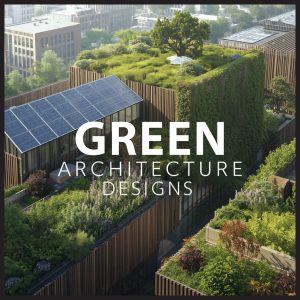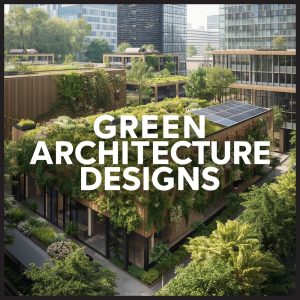Green Architecture Designs
In the contemporary world, Green Architecture Designs are transforming the way we conceive, construct, and inhabit buildings. With urbanization, population growth, and environmental concerns on the rise, sustainable architecture has become essential for reducing carbon footprints, conserving resources, and creating healthier living environments. Embracing Green Architecture Designs ensures that buildings are not only aesthetically appealing but also environmentally responsible, energy-efficient, and socially beneficial.

Green architecture combines technology, design, and environmental science to minimize negative ecological impacts. From energy-efficient building materials to passive heating and cooling systems, each aspect of sustainable design contributes to reduced energy consumption and increased environmental harmony. By understanding and implementing Green Architecture Designs, architects, developers, and homeowners can create structures that align with long-term sustainability goals.
The Principles of Green Architecture
Green Architecture Designs are guided by principles that prioritize environmental stewardship, human health, and resource efficiency. One of the key tenets is energy efficiency — reducing energy demand through insulation, natural lighting, and efficient HVAC systems. Additionally, sustainable water management, waste reduction, and use of renewable energy sources are integral components.
Another principle is ecological integration. Buildings should harmonize with their surroundings, preserving natural landscapes, protecting biodiversity, and minimizing disruption to local ecosystems. Design strategies such as green roofs, vertical gardens, and permeable surfaces reduce heat islands, enhance air quality, and manage stormwater effectively.
Material selection is also critical in Green Architecture Designs. Sustainable materials, including recycled, locally sourced, and low-emission products, reduce environmental impacts while supporting the circular economy. Each design choice, from orientation to material, contributes to creating resilient and eco-friendly structures.
Energy Efficiency and Sustainable Building Systems
Reducing energy consumption is a cornerstone of Green Architecture Designs. Energy-efficient systems, such as LED lighting, smart thermostats, and energy recovery ventilation, lower operational costs while minimizing carbon emissions. Solar panels, wind turbines, and geothermal systems further reduce dependency on fossil fuels and provide renewable energy alternatives.
Passive design strategies enhance efficiency by leveraging natural elements. Proper building orientation, window placement, and shading devices optimize sunlight and airflow, reducing heating and cooling demands. Thermal mass materials, such as concrete or stone, regulate indoor temperatures by absorbing and releasing heat.
Smart building technologies, including automated lighting, energy monitoring, and IoT-enabled systems, allow real-time energy management. Integrating these solutions into Green Architecture Designs creates buildings that are both functional and sustainable, promoting environmental responsibility.
Sustainable Materials and Construction Techniques
Material selection plays a pivotal role in Green Architecture Designs. Using low-impact, recycled, and locally sourced materials reduces environmental degradation and supports sustainable industries. Bamboo, reclaimed wood, recycled steel, and low-VOC paints are examples of materials that balance performance with ecological considerations.

Construction techniques also influence sustainability. Prefabrication, modular construction, and 3D printing reduce waste, lower energy consumption, and shorten construction timelines. Implementing durable, low-maintenance materials ensures longevity while minimizing resource use over a building’s lifecycle.
Additionally, integrating natural materials, such as clay, stone, or rammed earth, enhances indoor air quality, thermal comfort, and aesthetic appeal. By combining innovative techniques with thoughtful material choices, architects can create structures that exemplify the essence of Green Architecture Designs.
Water Conservation and Management
Water efficiency is a key element of Green Architecture Designs. Rainwater harvesting, greywater recycling, and low-flow fixtures reduce water consumption and alleviate pressure on municipal supplies. Efficient irrigation systems and drought-resistant landscaping further conserve water while supporting sustainable landscaping practices.
Green roofs and permeable pavements play an important role in stormwater management, reducing runoff and mitigating urban flooding. Implementing water-sensitive urban design enhances resilience against climate-related challenges and promotes environmental harmony.
By integrating comprehensive water management strategies, architects and planners ensure that Green Architecture Designs are not only energy-efficient but also resource-conscious, supporting long-term sustainability.
Indoor Environmental Quality and Health
Healthy indoor environments are essential in Green Architecture Designs. Indoor air quality, natural lighting, thermal comfort, and acoustics directly impact occupants’ well-being and productivity. Low-emission materials, proper ventilation, and effective filtration systems minimize exposure to pollutants and allergens.
Daylighting strategies reduce the need for artificial lighting, improving both energy efficiency and mental health. Plants and biophilic design elements enhance air quality, reduce stress, and foster a connection with nature. Soundproofing, ergonomic layouts, and climate control contribute to comfortable and healthy interiors.
Prioritizing occupant health is a central aspect of Green Architecture Designs, demonstrating that sustainable buildings serve both environmental and human needs.
Renewable Energy Integration
Incorporating renewable energy systems is a defining feature of Green Architecture Designs. Solar panels, photovoltaic glass, and solar water heaters harness sunlight to reduce dependence on non-renewable sources. Wind turbines, geothermal heat pumps, and biomass energy provide additional sustainable energy options for residential, commercial, and industrial buildings.
Hybrid systems, combining multiple renewable sources, ensure reliable energy supply while minimizing environmental impact. Battery storage and smart grid connections allow for efficient energy distribution and self-sufficiency. By integrating renewable energy into design, Green Architecture Designs transform buildings into eco-friendly power generators.
Urban Green Spaces and Landscaping
Urban green spaces enhance sustainability and livability. Green Architecture Designs incorporate rooftop gardens, vertical greenery, courtyards, and parklets to reduce heat islands, improve air quality, and provide recreational spaces. These features support biodiversity, attract pollinators, and create aesthetically pleasing environments.
Landscape planning using native and drought-resistant plants conserves water, reduces maintenance, and supports local ecosystems. Green spaces also foster community interaction, educational opportunities, and mental well-being. By integrating landscaping into architectural planning, buildings become more than structures — they contribute positively to urban ecology and human life.
Smart Technology and Building Automation
Smart technologies enhance efficiency, comfort, and sustainability in Green Architecture Designs. IoT devices, sensors, and automated control systems monitor energy, water, and indoor conditions in real-time. Predictive analytics optimize energy usage, detect inefficiencies, and reduce waste.
Automated lighting, HVAC, and shading systems respond to environmental conditions, ensuring comfort while minimizing resource consumption. Integration with renewable energy systems, battery storage, and grid connections enhances energy reliability and sustainability.
Smart building technologies make Green Architecture Designs adaptive, responsive, and future-ready, aligning with modern sustainability objectives.
Lifecycle Assessment and Sustainability Metrics
Evaluating environmental impact across a building’s lifecycle is essential in Green Architecture Designs. Lifecycle assessment (LCA) measures energy use, emissions, and resource consumption from material production to construction, operation, and demolition.
Sustainability metrics, including LEED, BREEAM, and WELL certifications, provide frameworks for designing, monitoring, and reporting building performance. These standards encourage the use of eco-friendly materials, energy-efficient systems, and healthy indoor environments.
By applying rigorous assessment tools, architects and developers ensure that Green Architecture Designs meet environmental, economic, and social goals throughout their lifespan.
Adaptive Reuse and Renovation
Retrofitting existing buildings is a practical aspect of Green Architecture Designs. Adaptive reuse reduces demolition waste, preserves cultural heritage, and minimizes energy use associated with new construction. Renovations incorporating energy-efficient systems, insulation, and sustainable materials extend building lifespans while reducing environmental impact.
Conversion of old industrial spaces into residential or commercial units exemplifies sustainable urban development. Adaptive reuse demonstrates that sustainability is not limited to new constructions but can be achieved through intelligent design interventions in existing structures.
Community Engagement and Social Impact
Sustainable architecture extends beyond technical solutions to include social responsibility. Green Architecture Designs foster community engagement, awareness, and education. Public spaces, community gardens, and shared facilities encourage collaboration, inclusivity, and environmental stewardship.
Educational programs, workshops, and interactive installations promote sustainable behaviors among occupants and the wider community. Socially responsive designs enhance quality of life, equity, and resilience. By combining ecological and social considerations, Green Architecture Designs create holistic environments that benefit people and planet alike.
Future Trends in Green Architecture
The future of Green Architecture Designs is driven by innovation, sustainability goals, and climate resilience. Emerging trends include net-zero energy buildings, circular construction, bio-inspired designs, and fully integrated renewable energy systems.

Advanced materials, including self-healing concrete, phase-change insulation, and energy-generating facades, push the boundaries of sustainability. Smart cities leverage data analytics, sensors, and connected infrastructure to optimize building performance and urban efficiency.
As architects, planners, and policymakers embrace these trends, Green Architecture Designs will continue to redefine urban living, making cities greener, healthier, and more sustainable for generations.
Conclusion
In conclusion, Green Architecture Designs combine aesthetics, functionality, and sustainability to address the challenges of modern urbanization. Energy efficiency, renewable energy integration, sustainable materials, water conservation, and smart technologies form the backbone of eco-friendly buildings.
Incorporating green spaces, healthy interiors, adaptive reuse, and community engagement ensures that sustainable architecture serves both people and the planet. By adopting Green Architecture Designs, architects, developers, and residents contribute to environmental stewardship, resource efficiency, and resilient urban landscapes.
The adoption of these principles is not merely a design choice — it is a commitment to a sustainable future. Every building, rooftop garden, and green wall represents a step toward a more balanced, healthy, and thriving urban environment. Embracing Green Architecture Designs today ensures that cities of tomorrow are innovative, resilient, and environmentally responsible.
